ISSUE NO. 20: WHAT CAN PUBLIC COMMENTS TO ENVIRONMENTAL IMPACT STATEMENTS TELL US ABOUT THE VIABILITY OF OFFSHORE WIND DEVELOPMENT?
Analysis of Public Comments on Vineyard Wind Supplement to the Draft Environmental Impact Statement (Part 1 of an occasional series of articles)
On June 12, 2020 the Bureau of Ocean Energy Management (BOEM) released a Supplement to the Draft Environmental Impact Statement (“EIS”) for the proposed Vineyard Wind I offshore wind project considering cumulative impacts of multiple offshore wind developments off the US East Coast.
As a case study on community engagement and stakeholder perceptions, Acorn International reviewed and analyzed the public comments on the EIS. Our goal was to identify patterns in these comments that would provide insight on issues of importance to the public and differences in opinion between stakeholder groups that might inform future stakeholder and community engagement.
HOW MANY COMMENTS WERE RECEIVED?
- 13,259 comments were received and are available for review on Regulations.gov.
- For comparison…
- 148 comments were received on the March 2018 Notice of Intent to prepare an EIS
- 349 comments were received on the December 2018 Draft EIS.
- For comparison…
- These comments include:
- Multiple mass mail campaigns
- 12,181 comments from one nationwide viral campaign
- Five smaller organized campaigns (50-100+ comments each)
- Three separate campaigns each submitted one comment but attached individual notes and signatures from their members
- Sierra Club: 7,111 signatures/notes
- National Wildlife Federation: 9,557 signatures/notes
- Garden State Seafood Association: 3,052 signatures
- Transcripts from five public online meetings (~900 pages)
- 738 unique comments that were not part of coordinated campaigns
- Multiple mass mail campaigns
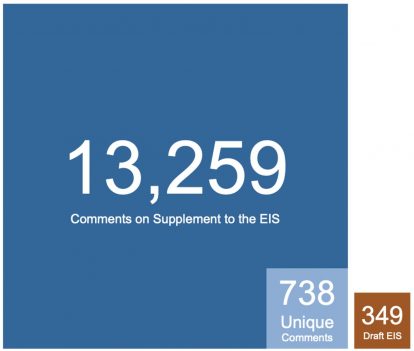
WHAT DO THE COMMENTS LOOK LIKE?
- Public responses were as varied as individuals. Comments ranged in format from:
- Formal syntax to casual notes brimming with misspellings
- Copy/pasted text blocks to unique observations
- One sentence commentary on renewable energy in general to personal accounts describing how the proposed project would affect that person’s life
- A single punctuation mark, the words “have a nice day”, or random pictures to 100+ pages of detailed scientific analysis with extensive scientific literature references
HOW DID WE ANALYZE THE COMMENTS?
- We reviewed all 13k+ comments and classified them as unique or part of a mass mail campaign
- We created a visual summary of the comments by using software to generate a word cloud showing the relative frequency of words used in all comments (including only one copy of mass mail campaign comments and excluding common English words and the word “wind”).
- We further reviewed and analyzed 738 unique comments, identifying key themes, positions, and perspectives.
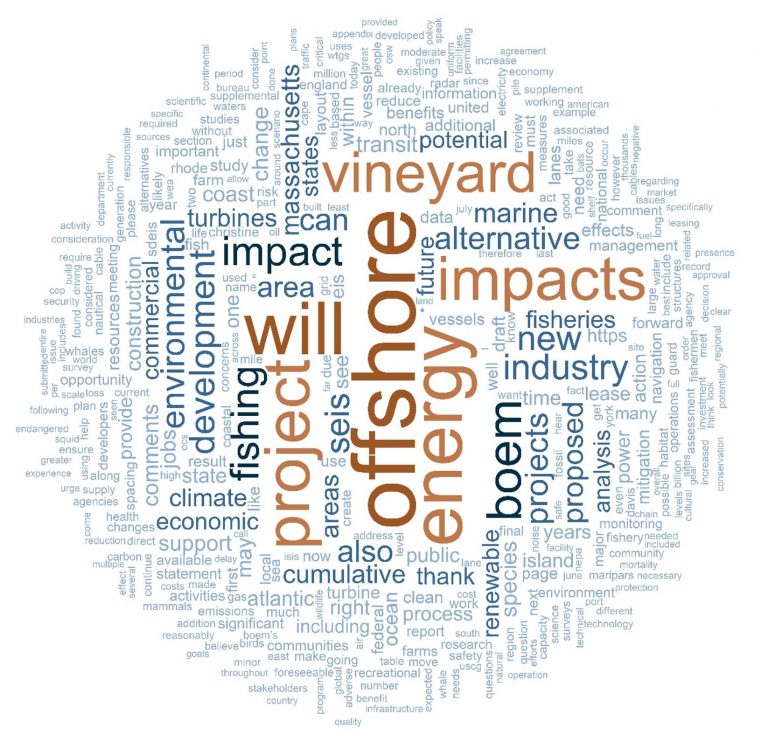
WHO COMMENTED?
- Relatively few commenters identified themselves, but of those who did:
- The largest groups of respondents were people with local connections, members of wind industry or supporting industries, and other individuals or groups with some sort of relevant specialist expertise. (~12% each)
- The next largest groups were commercial fishermen and government officials/agencies (~4% each; likely an underestimate of fishermen)
WHAT DO THE COMMENTS SAY?
(note: These figures are based on the 738 unique comments we analyzed in detail. Percentages may not add to 100% as some comments addressed multiple projects/topics or expressed multiple points of view)
- 503 (68%) discussed Vineyard Wind, 249 (34%) discussed offshore wind in general, and 10 (1%) discussed other projects entirely
- 499 (68%) were supportive (of either the Vineyard Wind I project or of offshore wind in general), 100 (14%) were opposed, 6 (1%) were unsure, and 119 (16%) didn’t state an opinion or position
- 200 (27%) specifically reference the contents of the EIS
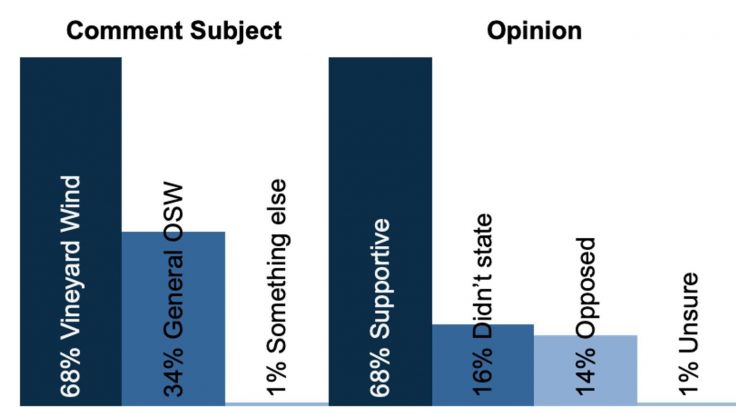
BUT REALLY, WHAT DO THE COMMENTS TALK ABOUT?
The tables below list the most frequently mentioned topics in the comments. While we didn’t count the number of times some themes were mentioned, we did note patterns in comments. These statistics are based on the 738 unique comments we analyzed in detail. These do not indicate a positive or negative position on these topics, only that they were mentioned. Percentages may not add to 100% as most comments addressed multiple topics.
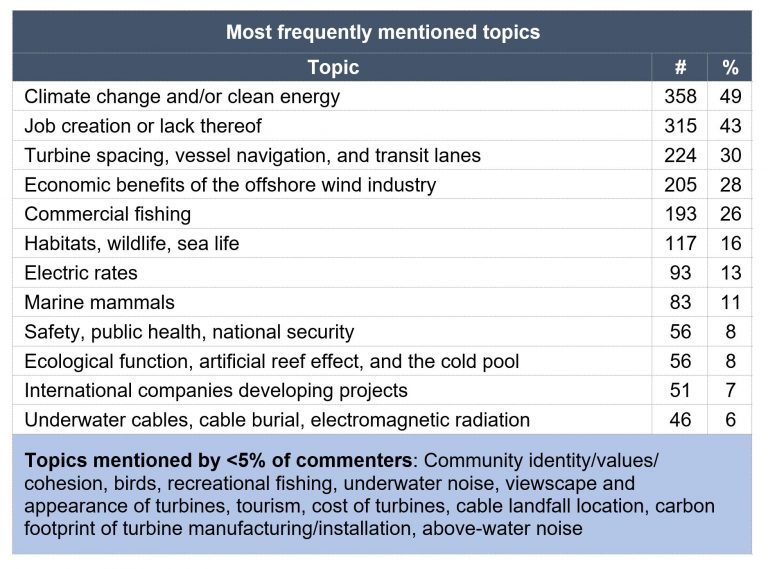

WHAT SURPRISED US?
It’s not surprising to see that the key issues of concern are related to climate/clean energy, fishing, jobs and economic benefits. Our experience in coordinating stakeholder engagement for both offshore wind and other offshore energy infrastructure development worldwide highlights that these as common issues of concern. What was surprising?
- There was a relative dearth of comments raised on marine mammals and recreation/viewscapes – issues that have been significant enough concerns to significantly delay or block offshore infrastructure developments worldwide, including offshore New England. Developers should be aware that these concerns are persistent and deeply rooted – and though not highlighted by the numbers, they will need to be carefully addressed to satisfy stakeholder concerns and reduce the risk of further delays.
- Further, while concerns about cable landing locations and on-shore environmental & community impacts were relatively few, these will become much more prominent concerns to be addressed as project planning progresses to identify and obtain approvals for on-shore cable & transmission routes.
WHAT ARE THE KEY TAKE-AWAYS AND IMPLICATIONS FOR PLANNING FUTURE OSW DEVELOPMENTS?
- The public is willing to engage. They want to engage! – The volume of comments received indicates the public is increasingly interested and wants to engage and be engaged. The nationwide nature of the comments also indicates interest in offshore wind developments is not just local. While coordinated mass mail campaigns were effective in bringing in comments from outside the New England region, individual commenters also came from outside the region.
Implication: Ensure stakeholder engagement plans and resources are calibrated to address national interests while maintaining a local presence and focus
- Interest does not equal understanding – Not all comments indicated an accurate understanding of the project or even offshore wind technology, however, commenters were very confident in their opinions. One of the most common words used in the comments is “will” (not “may” or “might” or “could”). Whether commenters feel offshore wind represents tremendous opportunity or untold destruction, they are confident their anticipated outcome will happen! Where only two years ago public comment sessions were dominated by questions and concerns, observers now appear to be forming more definitive positions on issues of concern – and this poses new challenges for OSW developers.
Implication: Be prepared to listen more to stakeholder opinions and adjust public communication and grievance management campaigns to be sensitive to accommodating, and where needed correcting, strongly held opinions and concerns.
- Some view the public comment process as a forum – Many comments were aimed at offshore wind in general or simply expressed a general positive or negative opinion on the Vineyard Wind I project. Far fewer comments specifically discussed the EIS (27%, calculated using a broad definition of “specifically discussed”). This indicates a large proportion of stakeholders seem to view the EIS public comment process as an outlet for expressing their views on the topic rather than a mechanism to comment on the EIS. Interestingly, commenters who specifically discussed the EIS, and particularly those who offered a detailed analysis of the document, were much less likely to express a positive or negative opinion on the project than those who did not specifically discuss the EIS.
Implication: Build the discipline to not be distracted by chatter, and to filter and focus on key issues of concern that could represent material impacts to the development or the physical/human environment.
- Getting community engagement right is difficult – Commenters both praised and criticized the engagement conducted by Vineyard Wind and BOEM. Some felt that they had been informed and involved in the process for years, while others felt their input was ignored or dismissed. This variable range and complexity of opinion shows how hard it is to build consensus yet reminds us of how critical it is to be able to do just that to ensure OSW wind developments can be executed in a timely and cost-effective manner.
Implication: Start community engagement planning early and invest enough “small money” up front with professional guidance and reliable team resources to minimize the unplanned “big money” risks later in the development process.
Stay tuned for upcoming Acorn Notes in which we will further analyze patterns in comments, looking at stakeholder’s support or opposition and their commentary on Vineyard Wind I versus offshore wind in general.
News & Notes
Acorn International
1702 Taylor St, Suite 200B
Houston, TX 77007, USA
1213 Purchase St
New Bedford, MA 02740, USA
